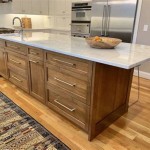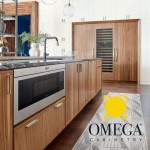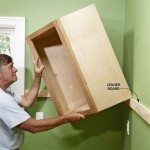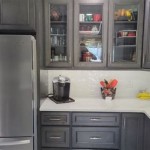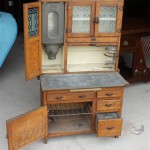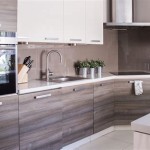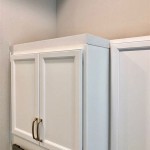```html
Restoring 1950s Metal Kitchen Cabinets: A Comprehensive Guide
The mid-20th century saw a surge in the popularity of metal kitchen cabinets, particularly in the 1950s. These cabinets, often constructed of durable steel and finished with bright, cheerful enamel, represent a significant aesthetic era. Today, many homeowners seek to restore these vintage pieces, preserving a piece of design history while incorporating unique elements into modern kitchens. Restoration requires careful planning and execution to maintain the cabinets' integrity and ensure a lasting finish.
This article provides a comprehensive guide to restoring 1950s metal kitchen cabinets, covering essential steps from initial assessment to final reinstallation. The goal is to equip individuals with the knowledge necessary to undertake this rewarding, albeit demanding, project.
Assessing the Condition of Your Metal Cabinets
Before commencing any restoration work, a thorough assessment of the cabinets' condition is crucial. This initial step dictates the scope of the project and helps identify potential challenges early on. The assessment should cover several key areas.
Firstly, examine the cabinets for rust. Rust is a common issue with vintage metal cabinets, especially in areas prone to moisture. Look for surface rust appearing as orange or brown discoloration, as well as more significant corrosion that may have eaten through the metal. The extent of rust damage will determine the necessary removal methods and potential need for patching or replacement of severely corroded sections.
Secondly, inspect the existing finish. Decades of use can lead to chipping, peeling, or fading of the original enamel. Evaluate the structural integrity of the paint layer. Is it firmly adhered to the metal, or is it flaking off easily? This assessment will determine the level of surface preparation required before applying a new finish. Minor imperfections might only require light sanding, while extensive damage necessitates complete stripping of the old paint.
Thirdly, assess the hardware. Original hardware, such as handles, hinges, and latches, often contributes to the cabinets' vintage charm. Check for functionality, wear, and damage. Are hinges loose or broken? Are latches functioning properly? Are handles missing or damaged? Decide whether to restore the original hardware or replace it with reproduction pieces. Restoration may involve cleaning, polishing, and repairing damaged components. Replacement hardware should ideally match the original style and finish to maintain the cabinets' authentic look.
Finally, evaluate the overall structural integrity of the cabinets. Check for dents, bends, or warping in the metal. Ensure that the cabinet boxes are square and that doors and drawers operate smoothly. Structural damage may require more extensive repairs, such as metal straightening or welding.
Preparing the Cabinets for Refinishing
Once the condition of the cabinets has been thoroughly assessed, the next step involves preparing them for refinishing. This process is critical for achieving a durable and aesthetically pleasing result. Proper preparation ensures that the new finish adheres correctly and protects the metal from future corrosion.
The first step in preparation is removing all hardware. Carefully detach handles, hinges, latches, and any other removable components. Label each piece and store it in a safe place to prevent loss or damage. This step allows for thorough cleaning and surface preparation of the cabinet bodies. It also facilitates the restoration or replacement of the hardware itself.
Next, clean the cabinets thoroughly. Use a degreasing cleaner and a scrub brush to remove any dirt, grease, or grime accumulated over the years. Rinse the cabinets with clean water and allow them to dry completely. This cleaning step is essential for removing contaminants that could interfere with paint adhesion.
After cleaning, address any rust issues. For surface rust, use a wire brush or sandpaper to remove the discoloration. For more severe rust, consider using a chemical rust remover or a power tool with a rust removal attachment. Ensure that all traces of rust are eliminated before proceeding to the next step. Failure to remove rust completely will result in the rust reappearing under the new finish.
Once the rust has been removed, it is time to prepare the surface for priming and painting. Sanding is a crucial step in this process. Use progressively finer grits of sandpaper to create a smooth, even surface. Start with a coarser grit to remove any remaining imperfections and then move to finer grits to refine the surface. Sanding provides a "key" for the primer to adhere to, ensuring a strong bond and a durable finish.
After sanding, wipe down the cabinets with a tack cloth to remove any residual dust. This final step ensures that the surface is clean and free of particles that could mar the finish. A clean surface is essential for optimal paint adhesion and a smooth, professional-looking result.
Refinishing and Reassembling the Cabinets
With the cabinets thoroughly prepared, the refinishing process can begin. Selecting the right type of paint and applying it correctly are crucial for achieving a durable and visually appealing finish that honors the original aesthetic.
Primer is the first layer to apply. Use a high-quality metal primer designed to prevent rust and promote paint adhesion. Apply the primer in thin, even coats, following the manufacturer's instructions. Allow the primer to dry completely before proceeding to the next step. Primer provides a uniform base for the paint and helps to seal any remaining imperfections in the surface.
Next, select the appropriate paint. For 1950s metal kitchen cabinets, enamel-based paints are a popular choice due to their durability and glossy finish, reminiscent of the original coatings. Consider using alkyd enamel or acrylic enamel paints. Alkyd enamels are known for their hardness and resistance to chipping, while acrylic enamels offer better color retention and are less prone to yellowing over time. Apply the paint in thin, even coats, allowing each coat to dry completely before applying the next. Multiple thin coats provide a smoother, more durable finish than one thick coat. Avoid drips and runs by applying the paint with a steady hand and using the correct spray technique if using a spray gun.
Consider using a paint sprayer for a professional-looking finish. Spraying provides a more even and consistent coating than brushing or rolling, especially on large surfaces. If using a sprayer, ensure that the paint is properly thinned according to the manufacturer's instructions. Practice your spraying technique on a scrap piece of metal before applying the paint to the cabinets.
If brushing or rolling, use high-quality brushes or rollers designed for enamel paints. Apply the paint in smooth, even strokes, avoiding excessive brush marks or roller stipple. Allow the paint to self-level as it dries. The finish should be smooth and free of imperfections. Lightly sand between coats with fine-grit sandpaper to remove any imperfections and create a smoother surface for the next coat.
Once the paint is fully dry and cured, reassemble the cabinets. Reattach the hardware, ensuring that all screws are tightened securely. Replace any worn or damaged hinges, latches, or handles as needed. Carefully reinstall the doors and drawers, adjusting them as necessary to ensure smooth operation. Lubricate hinges and latches to prevent squeaking and sticking. Take care not to scratch the new finish during reassembly.
Finally, inspect the finished cabinets. Look for any imperfections in the paint, such as runs, drips, or orange peel. Touch up any problem areas as needed. Clean the cabinets with a mild detergent and water to remove any dust or fingerprints. The restored 1950s metal kitchen cabinets should now be ready for installation, adding a touch of vintage charm to the kitchen.
```
How Can I Change Up Old Metal Kitchen Cabinets Besides Painting Them Hometalk

The History Of Vintage Steel Kitchen Cabinets 100 Brands Retro Renovation

22 Before And After Vintage Metal Cabinet Kitchen Cabinets Painting

Our 50s Kitchen Renovation Cabinet Restoration Natalie Curtiss Ilration

Kitchen Cabinets Redo Okay The Fridge Comes Too Mary Olive Design

Ann Recreates The Look Of Vintage Metal Kitchen Cabinets In Wood

Our 50s Kitchen Renovation Cabinet Restoration Natalie Curtiss Ilration

Garth And Martha Have Pro S Soda Blast Electrostatically Paint Their Vintage Crosley Steel Kitchen Cabinets Retro Renovation

This Time Capsule Ge Steel Kitchen Has Almost Everything Kitchens Were Famous For Retro Renovation

48 Best Steel Metal Kitchen Cabinets Beautiful Photos Vintage
Related Posts

